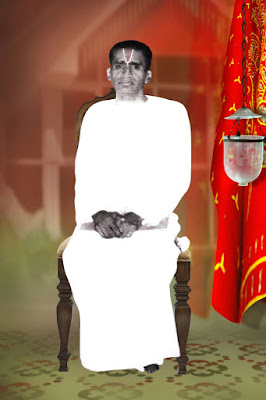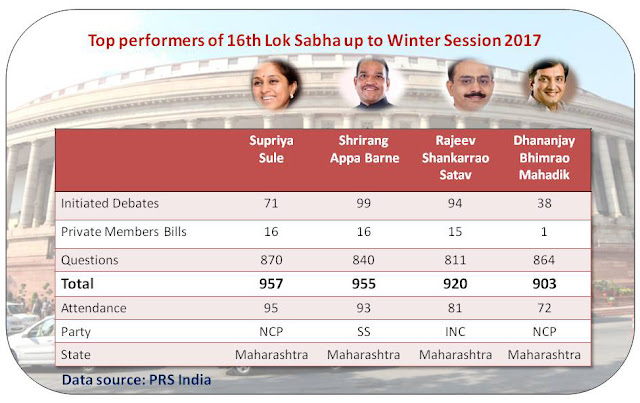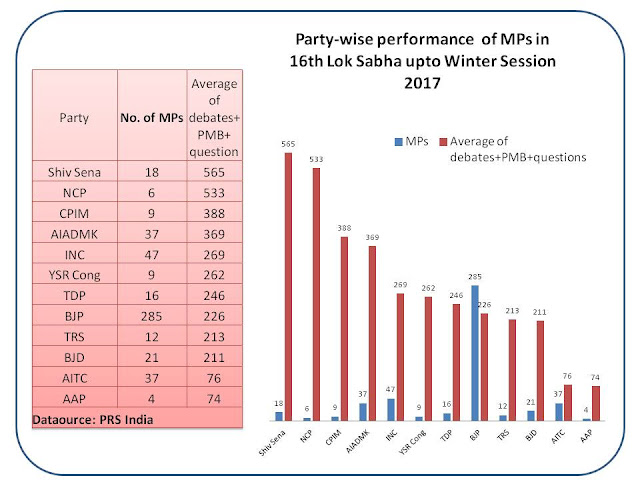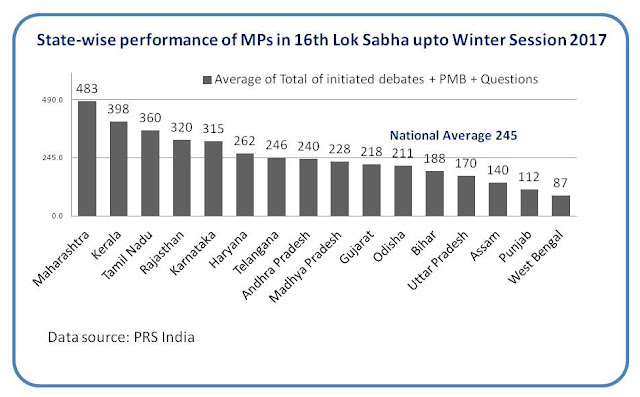Friday, 26 January 2018
Performance of MPs in the 13th Session of the 16th Lok Sabha - A quick analysis
Thirteenth Session of the 16th Lok Sabha was held from 15th Dec 2017 to 5th Jan 2018. This Session had 13 sittings. The performance at a glance is given in this graphics.
Productivity
During the session, Lok Sabha worked for 78% of its scheduled time, while Rajya Sabha worked for 54%. So far in the 16th Lok Sabha, the average productivity of Lok Sabha is 92% and that of Rajya Sabha is 73%. ▪ Time was lost due to disruptions regarding certain statements made during the recent state elections, and the protests related to the Bhima Koregaon issue. Out of 13 sittings, Lok Sabha sat beyond its scheduled time on six days (approximately eight hours). On the other hand, Rajya Sabha sat beyond its scheduled time on two days.
More time spent on legislative business
In this session, both the Lok Sabha (48%) and Rajya Sabha (42%) spent the largest share of their time on legislative business. This was the highest recorded in the 16th Lok Sabha. Both the Houses also recorded one of the lowest share of time spent debating other issues of public importance. Since 2014, Rajya Sabha has spent more time debating issues other than Bills. However, in this Winter Session, this trend was reversed where the time on legislative business exceeded other debates.
17 Bills were introduced in this Session and 13 were passed. AT the end of 13th Session, 67 Bills are still pending before the Parliament.
Top Performers – Individuals
This chart indicates the performance of Top 4 MPs of Lok Sabha, based on the debates initiated, private members bills and questions. PreSense Congratulates the Top Performers. It is a cumulative achievement for all the 13 Sessions of 16th Lok Sabha.
Interestingly, all the top four performers hail from Maharashtra State.
Party-wise performance
Among the major political parties, Shiv Sena and Nationalist Congress Party (NCP) have topped the performance till the end of 13th Session. All India Trinamool Congress (AITC) and Aam Aadmi (AAP) Party have shown poor performance. (Small parties are not taken into account for analysis).
State-wise Performance
Maharashtra has done extremely well followed by Kerala and Tamil Nadu. West Bengal has done poorly. (Small States and UTs not taken for analysis. Only major states are analysed).
PreSense congratulates all the individual top performers, top performing Parties and the States. The Fourteenth Session (Budget Session 2018) will commence on 29th January 2018. Our Sansad Ratna Awards, instituted by the eMagazine PreSense and Prime Point Foundation will be based on the performance upto the end of second party of the Budget Session with more additional parameters.
Data source: Lok Sabha Secretariat and PRS India.
By K. Srinivasan, Mg. Editor, PreSense
Saluting the forgotten hero Arya Bhashyam, who hoisted Indian Flag at Fort. St. George in 1932
 |
Shri Arya Bhashyam, who hoisted
the
Indian Tricolour, after removing the
Union Jack in 1932 – a rare photo
|
On 15th August 2016, India celebrated her 70th Independence Day. During the freedom struggle, many patriots had come out and fought against the British Raj, spending the prime of their youth in prisons. These patriots had also contributed to the independence and freedom we now enjoy. Their families suffered. Many of these patriots’ grandchildren lead very simple lives. Sadly, but for a few top national leaders, several thousands of great men and women are not even known to the present generation.
The media, especially the television channels rarely talk about the freedom struggle and the sufferings of these great men and women who struggled for this freedom. During the Independence Day and Republic Day celebrations, the mainstream freedom fighters are lauded, with no mention about the true UnSung Heroes. Our school text books too recognise only a couple of the leaders of the Independence period. Many citizens across the country prefer to spend these national holidays entertaining themselves.
Many Indians are under the impression that our National Flag has been flying atop only since 15th August 1947. Very few are aware that on 26th January 1932 at 2 am, someone had dared to bring down the Union Jack and hoist the Indian Tricolour at the prestigious flag post of Fort St. George at Madras. This was by a 25-year-old vibrant youth named Arya K Bhashyam.
In 1919, as a young 12-year-old student, K Bhashyam (Arya was his pen name) was disturbed to hear about the massacre of hundreds of innocent people at Jallianwala Bagh by General Dyre. He was also inspired by Vanchinathan, who shot and killed Collector Ashe in 1911 and later killed himself at Maniyachi Railway station. Bhashyam purchased four pistols secretly to kill the then Governor of Madras Province and later shoot himself. However, when he stood before the Governor face to face, ready to shoot him, a spark crossed his mind and he resolved not to resort to violence, but follow Mahatma Gandhi.
Spurred by Lokmanya Bal Gangadhar Tilak's vision of Swaraj, Bhashyam became a firebrand revolutionary and dared several feats protesting against the British colonial rule. He was imprisoned several times and tortured by the police.
The Fort St. George, Madras was built in 1644 by the British rulers as their first fortress in India. In 1687, they erected a 148-foot high flag post made of teakwood to stand as the tallest in the country. The Union Jack used to be hoisted on that flag post everyday. The British considered these two among the most prestigious emotional accomplishments by them.
 |
Fort
St George and the Teakwood Flag Staff (100 years ago)
|
26th January was considered the Swarajya Day by the Congress leaders then. Bhashyam wanted to hoist the Indian Tricolour on the Flag Post on Swarajya Day in 1932. Two days in advance, he personally made a large tricolour flag, using his dhoti and wrote in Tamil “இன்றிலிருந்து இந்தியா சுதந்திரம் அடைந்தத்து” (“From today India has attained independence”). He tied the tricolour dhoti on his waist to skip the notice of the security personnel. In the early hours of 26th January 1932 at 2 am, he arrived at the flag post. Arya Bhashyam shinned up the 148-foot flag post, removed the Union Jack from the ropes and hoisted the Indian tricolour. The Union Jack was torn into pieces.
No doubt, seeing the Indian tricolour flying atop the flag post infuriated the British and two days later, they arrested Arya Bhashyam and sentenced him to rigorous imprisonment in the Central Jail. He was treated as a ‘dangerous prisoner’ and kept in quarantine. Netaji Subash Chandra Bose was also brought to the Madras prison during that time. Both Arya Bhasyam and Netaji became close associates.
In an exclusive interview to the All India Radio during 1970s, Arya Bhashyam described the torture he faced with the police in the jail. He said he was given 30 lashes for questioning their atrocities. He continued to shout ‘Vandemataram’ while he was being given the lashes by the police.
Bhashyam was an artist and sculptor. After independence, he returned to a quiet and simple life. He refused the pension given to freedom fighters. He died in 1999 at the age of 93. It is also reported that he studied at National College, Tiruchi.
The Indian tricolour was hoisted in all the states, including Delhi on 15th August 1947. But Bhashyam accomplished this, way back in 1932.
Today, only a few records have registerd his achievements. With great effort, PreSense traced his only available photograph. The teakwood flag post was replaced in 1994 with a steel replica by the State Government.
In every district of the country, there were thousands of such Arya Bhashyams, who are not known to the present generation. Both the Central and the State Governments should initiate efforts to identify these UnSung warriors and inform about their contributions, for the knowledge of the present generation. PreSense salutes these great men and women, who had contributed to India’s freedom.
Jai Hind
By Prime Point Srinivasan
(This article was published as cover story in the eMagazine PreSense in August 2016 issue)





















